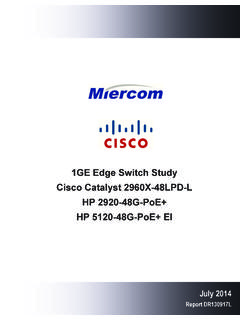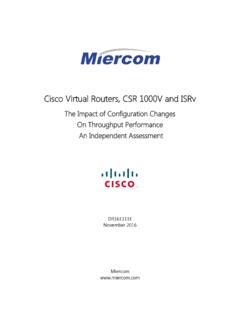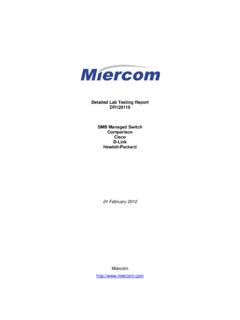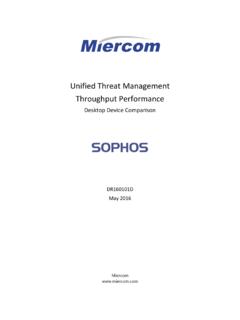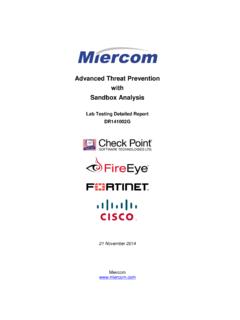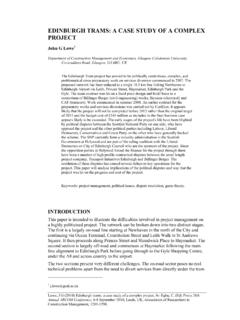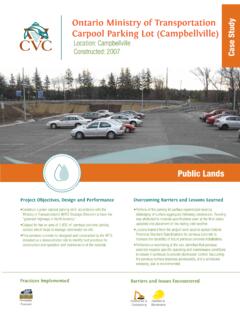Transcription of Speeding Applications in Data Center Networks - Miercom
1 Speeding Applications in data Center Networks The Interaction of Buffer Size and TCP Protocol Handling and its Impact on data -Mining and Large Enterprise IT traffic Flows DR160210F February 2016 Miercom Speeding traffic in data - Center Networks 2 DR160210F Miercom Copyright 2016 22 February 2016 Contents 1 Executive Summary .. 3 2 - TCP Congestion Control versus System Buffer Management .. 4 TCP Congestion Control .. 4 Buffering Issues with TCP .. 5 3 - TCP Flow Sizes: Mice and Elephants .. 6 Deep Buffer versus Intelligent Buffer .. 7 4 - Test Bed: data Mining and Buffers.
2 8 About the Tests and Flows Applied .. 9 Buffers and Buffer Utilization .. 10 5 Results .. 11 Average Flow Completion Times for All Flows .. 11 Mice: Under 100-KB Flow Completion Times .. 12 100-KB to 1-MB Flow Completion Times .. 13 1-to-10-MB Flow Completion Times .. 14 Elephants: Over-10-MB Flow Completion Times .. 15 6 Results with the Large Enterprise IT traffic Profile .. 16 7 - Test Conclusions .. 19 8 References .. 20 9 - About Miercom Testing .. 21 10 - About 21 11 - Use of This Report .. 21 Speeding traffic in data - Center Networks 3 DR160210F Miercom Copyright 2016 22 February 2016 1 Executive Summary How can I speed up my network data ?
3 The answer is not a simple one, as there are at least a dozen parameters that collectively impact how fast a data file can move from one point to another. Some of these you can t do much about. Propagation delay, for example the speed-of-light delay. It will always take longer to move the same file across country than between servers within a data Center , especially with a connection-oriented protocol like TCP. But don t look to change TCP either: The dynamic duo of TCP and IP was standardized decades ago for universal Internet interoperability and can t readily be altered either. But there are aspects of data Networks that the user can change or modify to improve performance, such as in the architecture and features of the switches and routers selected.
4 Switch-routers are not all created equal: The optimum architecture and feature set for traffic handling within a data Center are quite different from a LAN-WAN router or a remote, branch-office switch. One hotly debated question is about one aspect of the data Center network design. How big a buffer should be, or what kind of buffering functions needed on the switches in order to best support Applications that involves bursty traffic . Would big buffer help or make it worse for incast /microburst traffic ? Miercom was engaged by Cisco Systems to conduct independent testing of two vendors top-of-the-line, data - Center switch-routers, including the Cisco Nexus 92160YC-X and Nexus 9272Q switches and the Arista 7280SE-72 switch.
5 These switch products represent very different buffer architectures in terms of the buffer sizes and the buffer management. The objective: given the same network -intensive, data - Center application and topology, the same data flows and standard network and transport protocol, how do they compare in terms of how fast TCP data flows are completed? With the real-world traffic profiles, our testing results show that the Cisco Nexus 92160YC-X and Nexus 9272Q switches outperformed the Arista 7280SE-72 switch for congestion handling. The Arista 7280SE-72 switch has much deeper buffer than the Cisco switches, but with the built-in intelligent buffer management capabilities, both Cisco switches demonstrated clear advantage in flow completion time for small/medium flows over the Arista 7280SE-72 switch and provided the same or similar performance for large-size flows, which resulted in overall higher application performance.
6 The environment tested here incorporated and focused on: A specific environment: A high-speed data - Center network linking 25 servers. Two specific traffic profiles from production data centers: o A data mining application o A typical large enterprise IT data Center data flows of widely varying sizes, from under 100 KB to over 10 MB, heavy buffer usage, and link loads to 95 percent. Standard New Reno TCP flow control as the transport layer protocol The key metric: How long to complete data transfers (flow completion times)? What was tested, and how, and results relating to switch-router buffer size and TCP data -flow management are detailed in this paper.
7 Robert Smithers CEO Miercom Speeding traffic in data - Center Networks 4 DR160210F Miercom Copyright 2016 22 February 2016 2 - TCP Congestion Control versus System Buffer Management This study focused on two components of networking, which together play a major role in how fast it takes a flow a data transfer, like an email message, a file transfer, a response to a database query, or a web-page download to complete. They are: TCP congestion control. The Transmission Control Protocol (TCP) is the Layer-4 control protocol (atop IP at Layer 3) that ensures a block of data that s sent is received intact.
8 Invented 35 years ago, TCP handles how blocks of data are broken up, sequenced, sent, reconstructed and verified at the recipient s end. The congestion-control mechanism was added to TCP in 1988 to avoid network congestion meltdown. It makes sure data transfers are accelerated or slowed down, exploiting the bandwidth that s available, depending on network conditions. System buffer management. Every network device that transports data has buffers, usually statically allocated on a per-port basis or dynamically shared by multiple ports, so that periodic data bursts can be accommodated without having to drop packets.
9 network systems such as switch-routers are architected differently, however, and can vary significantly in the size of their buffers and how they manage different traffic flows. TCP Congestion Control To appreciate the role TCP plays, it s helpful to understand how congestion control is managed. TCP creates a logical connection between source and destination endpoints. The actual routing of TCP data , finding how to make the connection and address packets, is relegated to the underlying IP protocol layer. Congestion is continually monitored on each separate connection that TCP is maintaining.
10 A built-in feedback mechanism lets TCP determine whether to send more packets, and use more network bandwidth, or to back off and send less packets due to congestion. A destination acknowledges packets received by sending back ACK messages, indicating receipt. With each ACK, TCP can incrementally increase the pace of sending packets to use any extra available bandwidth. Similarly, TCP deduces that a packet has been lost or dropped after receiving three duplicate ACKs without an acknowledgement for a particular outstanding packet. TCP then considers the packet loss as a congestion indication, and then backs off and cuts its transmission rate, typically in half, to reduce the congestion in the network .
